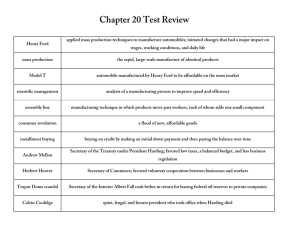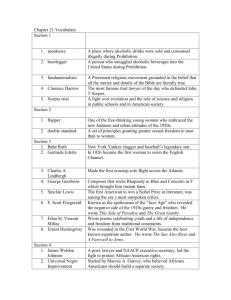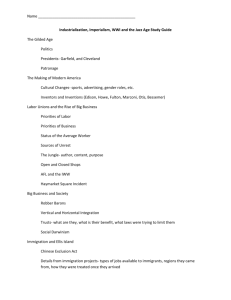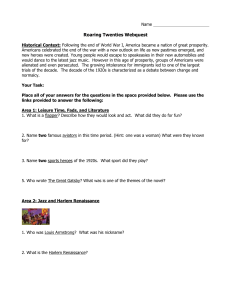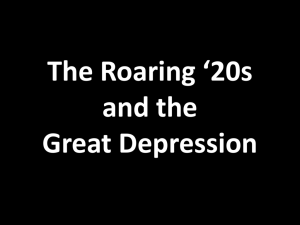Jazz Age Culture 1920s Hollywood Silent Films
advertisement
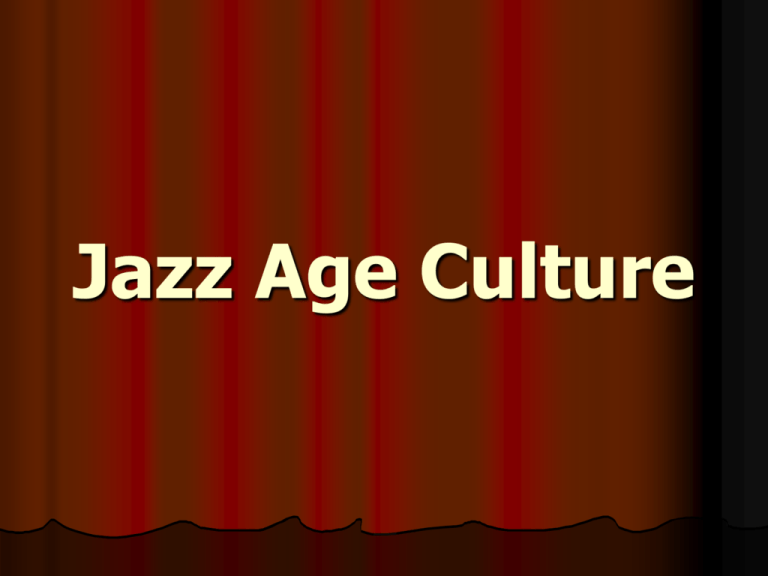
Jazz Age Culture 1920s Hollywood Silent Films Motion pictures initially did not have sound, so audiences had to be able to understand plots through entirely visual means; this forced actors to use highly exaggerated motions Many early films were comedies because “slapstick” provided effective visuals Most successful actor of the 1920s was comedic star Charlie Chaplin Metropolis (1927) Silent film made in Germany which many consider to be the first significant “science fiction” film ever made Silent movies, since they used no spoken language, could be effectively played anywhere in the world The Jazz Singer (1927) First “talkie” or film which had a synchronized soundtrack for dialogue This film’s success spelled the end of the silent picture era Sports Many spectator sports were extremely popular, including golf, tennis, boxing, and swimming Baseball had become “America’s pass time” Football began to gain prominence with the founding of the National Football League (NFL) in 1920 “Red” Grange 1903 – 1991 “The Galloping Ghost” The first American football star, Grange played for the University of Illinois and then for the NFL’s Chicago Bears as a star running back Jack Dempsey 1895 – 1983 World Heavyweight champion from 1919 to 1926 First boxer to draw more than $1 million in ticket revenues for a fight “Babe” Ruth 1895 – 1948 Played for 21 years (1914 – 35), mostly for the NY Yankees Hit 714 home runs (still 3rd most ever) Lived a celebrity lifestyle – drank heavily, smoked, and womanized – a trend he started that lives on today with many professional athletes The Lost Generation Term used to describe the generation which reached adulthood during the 1920s These young people were “lost” in that they felt trapped by the corrupt, greedy society in which they lived and their own experiences in WWI F. Scott Fitzgerald 1896 – 1940 Author of The Great Gatsby (1925) Wrote numerous shortstories (including The Curious Case of Benjamin Button) and screenplays in addition to his 4 novels Died from a heart attack induced by alcoholism Ernest Hemingway 1899 – 1961 Author of novels such as The Old Man and the Sea, A Farewell to Arms, The Sun Also Rises, and For Whom the Bell Tolls Rugged adventurer who liked bullfighting, hunting, mountain climbing, and other dangerous hobbies Committed suicide due to depression and alcoholism T.S. Eliot 1888 – 1965 American author, playwright, and poet Famous works include the play Murder in the Cathedral, and poems The Love Song of J. Alfred Prufrock, and The Waste Land Eugene O’Neill 1888 – 1953 American playwright His plays were among the first to include speeches in American vernacular and involve characters on the fringes of society, engaging in depraved behavior, where they struggle to maintain their hopes and aspirations, but ultimately slide into disillusionment and despair Charles Sheeler 1883 – 1965 American artist Modernist Supported himself by working as a commercial photographer who specialized in architecture; much of this experience is reflected in his painting Works by Sheeler John Marin 1870 – 1953 Modernist artist best known for his watercolors and abstract landscape paintings Work by Marin Edward Hopper 1882 – 1967 Realist painter Many of his paintings are dark and feature scenes of urban life Focused on using light and shadow and on placement of his figures within his paintings to strike the proper mood Nighthawks by Hopper Harlem Renaissance African-American cultural movement of the 1920s and 1930s, centered around the Harlem neighborhood of NYC Included new literary, artistic, and musical styles which would go on to heavily influence American culture of the mid and late 20th century Claude McKay 1889 – 1948 Writer and poet who wrote novels Home to Harlem, Banjo, and Banana Bottom One of the first authors of the Renaissance, McKay represented a new AfricanAmerican voice, one which rejected the ideals of Booker T. Washington, W.E.B. Du Bois, and Marcus Garvey, in favor of taking pride in his culture and pursuing full civil rights and racial solidarity Langston Hughes 1902 – 1967 American novelist, playwright, short story writer, and magazine columnist Pioneered new form of poetry known as “jazz poetry” Much of his work focuses on the theme “black is beautiful” and takes pride in the diversity of African-American culture The Cotton Club 1920 – 1940 Famous Harlem nightclub which featured jazz and blues music Catered to a mostly white audience, so marked the first significant exposure for many whites to black musical styles The Apollo Theater Harlem theater which originally opened in 1914, but didn’t become a predominantly black venue until 1934 Fell into decline in the 1960s and even became just a simple movie theater before being revived in 1983; today it has protected federal landmark status Louis Armstrong 1901 – 1971 Nicknamed “Satchmo” Jazz trumpeter and singer Popularized “scat” or singing using disjointed syllables instead of words Rose to fame quickly during the 1920s and was equally popular with both black and white audiences Duke Ellington 1899 – 1974 Orchestra leader, pianist, and song writer Elevated jazz from an urban musical form to a nearly classical level with his “big band” style Led his orchestra for over 50 years Billie Holiday 1915 – 1959 Crossed jazz over to standard “pop” (popular music) Also a song writer, helping write such hits as “God Bless the Child” and “Lady Sings the Blues” Unfortunately, she became a lifelong drug addict and died from liver failure after years of legal troubles Josephine Baker 1906 – 1975 Dancer, singer, and actress Baker was the first African American to star in a major motion picture, to integrate an American concert hall, and to become a worldfamous entertainer Extremely popular in Europe, her exotic stage show featured her scantily clad or even nude In later years she became heavily involved in the Civil Rights movement Charlie Poole 1892 – 1931 North Carolina musician who, along with his band the North Carolina Ramblers, became the first major national country music recording act When not recording, he earned money as a textile mill worker and as a moonshiner Died of an alcohol induced illness at just 39



